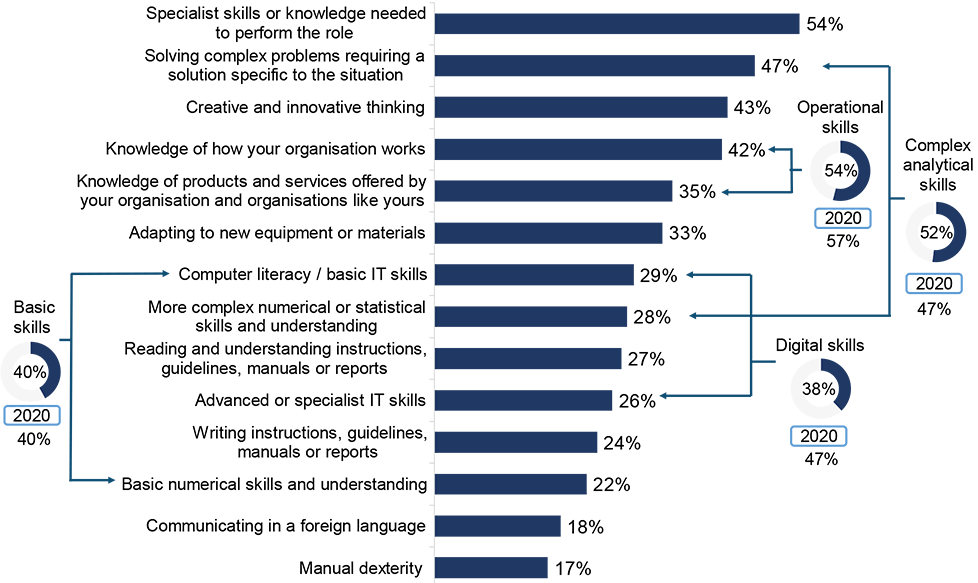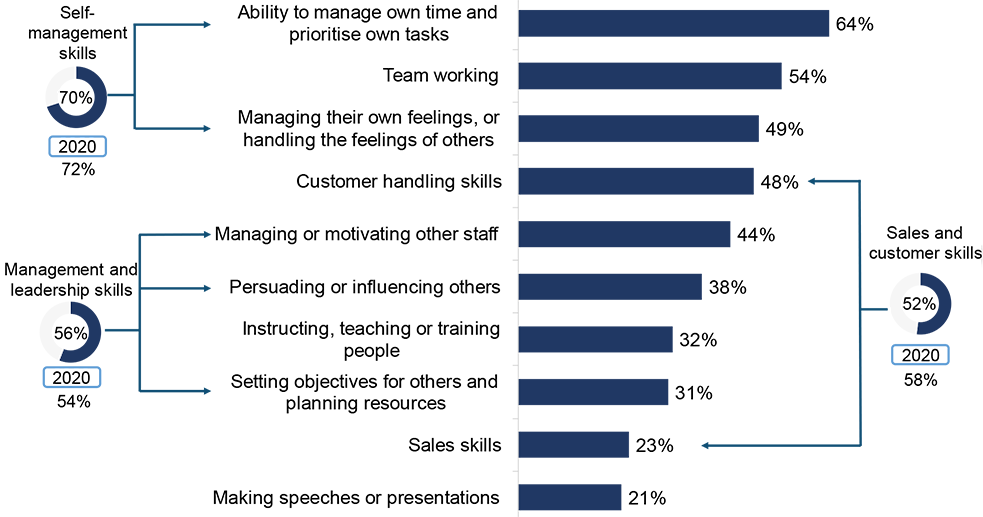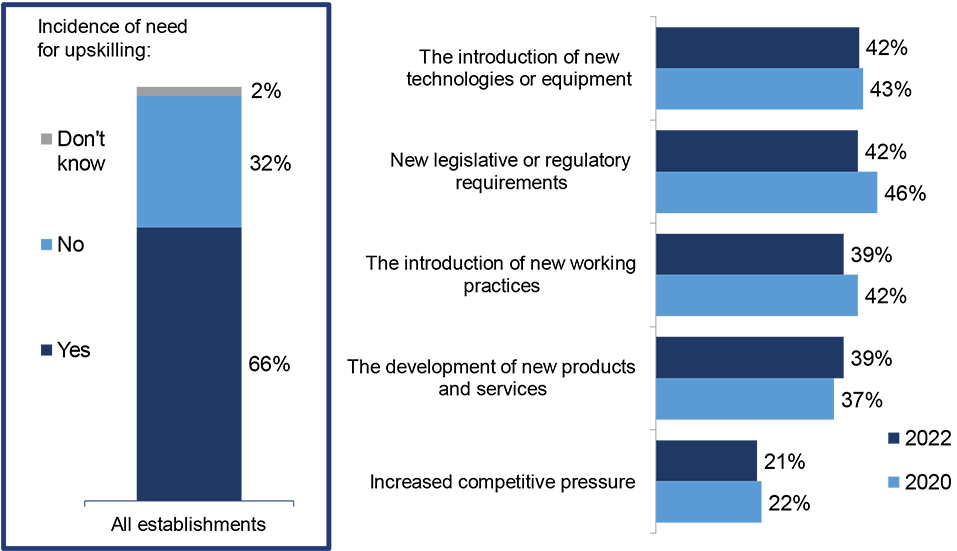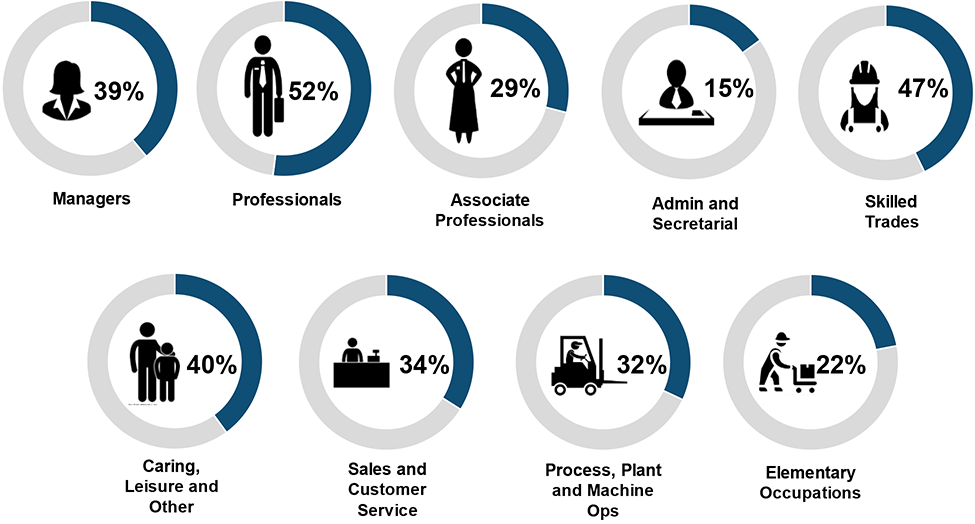UK Employer Skills Survey 2022 – Scotland Report
Publication of Scotland results from the UK Employer Skills Survey 2022.
The internal skills challenge
This chapter explores the prevalence and impact of current skills gaps within the Scottish workforce, i.e., the extent to which employers have staff that are not fully proficient in their job role. Some skills gaps may be temporary by nature, for example where new staff have been recruited who are not yet fully trained or experienced. However, others can be more persistent and a result of under-investment in training and development, staff reluctance to develop existing skills, or high staff turnover. Persistent skills gaps can affect an establishment’s productivity and ability to innovate[2].
The Employer Skills Survey (ESS) measures the incidence, volume, density of skills gaps, overall and at a national, sectoral and occupational level. Also covered in this chapter are the specific skills that employers identified as lacking among their employees, and the causes and the impacts of these. Finally, this chapter also covers the incidence and density of skills being underutilised as well as the expected need for upskilling in the next year.
- Skills gap incidence is the proportion of establishments judging at least one employee not fully proficient.
- Skills gap density is the number of employees that were judged not fully proficient as a proportion of all employees.
- Skills gap volume is the number of employees that were judged not fully proficient.
Incidence, volume and density of skills gaps
Overall, 15% of employers had skills gaps within their current workforce. This is higher than the 12% of employers reporting this in 2020, but consistent with 16% of employers in 2017.
The incidence of skills gaps rose by establishment size from 7% among those with 2 to 4 employees to 39% among those with over 100 employees.
Establishments in the Education (21%), Public Administration (21%) and Manufacturing (19%) sectors were most likely to have skills gaps. Public Administration and Education
were also among the sectors with the highest incidence of skills gaps in 2020 as well (19% and 17% respectively). Establishments in the Primary Sector and Utilities (8%) and Arts and Other Services (11%) were the least likely to have skills gaps in 2022.
In total, there were around 119,000 employees not fully proficient in 2022, representing 4.8% of the workforce in Scotland.
This is in line with 2020 when 4.0% of the Scottish workforce were considered to be not fully proficient in their roles, and with 2017, when the figure was 5.0%. In 2022, there was very little variation in skills gaps incidence by ROA region, all ROA regions having a density between 13% (Fife and Forth Valley) and 18% (Ayrshire).
The proportion of the workforce deemed by employers to not be fully proficient at their job (skills gaps density) was highest in employers with 50 to 99 employees (5.8%), whereas in 2020 the highest density of skills gaps was among employers with over 100 staff. By sector, the highest proportion of employees with skills gaps was in the Education (8.8%), Financial Services (8.7%) and Hotels and Restaurants (7.5%) sectors, while the Health and Social Work and Transport and Storage sectors had the lowest density (both 2.5%).
By broad occupation group the highest density of skills gaps was observed among middle-skill occupations (5.8%) (more information on broad occupational groupings can be found in the full UK report, which will be available on DfE’s website). The individual occupations with the highest density of skills gaps were Skilled Trades occupations (6.3%) and Sales and Customer Service occupations (6.2%). The lowest density of skills gaps was reported among Managers (2.4%), as was the case in 2020 (1.5%). Most occupations registered an increase in skills gaps density since 2020, notably among Administrative occupations (2.9% in 2020 compared to 5.6% in 2022) and Professional occupations (3.0% in 2020 compared to 5.4% in 2022). The only occupations with a lower proportion of employees with skills gaps were Associate Professionals (2.9%, down from 3.9% in 2020) and Caring, Leisure and Other Services occupations (4.0%, down from 6.2% in 2020).
Figure 13 shows the incidence of skills gaps (i.e., the proportion of employers reporting any skills gaps) overall for Scotland and by ROA region, and the density of skills gaps (the proportion of the workforce considered to lack full proficiency).
The highest proportion of staff with skills gaps in 2022 was recorded in the West (8.7%), West Lothian (7.1%) and Tayside (6.7%) ROA regions.
Skills gaps were most common among employers in Ayrshire, though the highest skills gaps density was found in the West ROA region

Base: All establishments in Scotland (2020: 3,497; ROA regional base sizes range from 87 in West Lothian Region to 500 in Highlands and Islands Region. 2022: 5,207; ROA regional base sizes range from 165 in Borders Region to 777 in Highlands and Islands Region.)
Further data on the incidence and density of skills gaps, and corresponding 2020 results, can be found in Tables 46 to 51 of the Background Tables.
Causes of skills gaps
Most skills gaps (80%) were caused at least in part by transient causes, like people being new to the role and not having completed their training yet. A fifth (20%) were caused entirely by this.
Transient causes were the reason for more skills gaps than in 2020, when they accounted at least partially for 75% of skills gaps.
Positive transformational causes, like the introduction of new working practices (31%), the introduction of new technology (26%) and the development of new products and services (24%) were responsible at least in part for two-fifths (39%) of skills gaps. This is a slightly lower proportion than in 2020 (42%), though in 2020 “transformational” causes were also partly driven by the COVID-19 pandemic and the switch to remote working.
Other common causes of skills gaps were an inability to recruit staff with the required skills (41%), staff lacking motivation (34%) and staff having not received the appropriate training (32%). The causes of skills gaps are presented in Figure 14.
Transient causes such as being new to the role or training being incomplete are the most common causes of skills gaps

Base: All establishments in Scotland with skills gaps (2022: 1,100; 2020: 638). Figures shown are based on skills gaps for up to 2 occupations randomly selected for each establishment – so, for example, “they are new to the role” was a cause of 66% of skills gaps followed up.
Further data on the causes of skills gaps, and corresponding 2020 results, can be found in Table 52 of the Background Tables.
Skills lacking internally
Employers were asked what skills were missing among their workforce. These were split into two broad categories: technical and practical skills, specific to the particular function of the job role, and people and personal skills, the “softer”, less tangible skills required to manage oneself and interact with others in the workplace.
The most common practical and technical skills lacking among the workforce were specialist skills or knowledge needed to perform the role (54%) and the ability to solve situation specific complex problems (47%).
These were also the most common technical skills lacking in 2020, accounting for, in part, 49% and 41% of skills gaps respectively.
Looking at the groups of skills missing, operational skills, namely knowledge of how the organisation works and knowledge of the products and services offered by their organisation, were the most common, lacking among 54% of employees with skills gaps. This is a slight reduction from 2020 when 57% of employees with skills gaps lacked operational skills. Complex analytical skills, like solving complex problems and complex numerical or statistical skills, were also lacking among 52% of employees with skills gaps, more than in 2020 (47%). Basic skills including basic IT skills and basic numerical skills maintained the same level as in 2020 (both 40%).
Other notable individual technical and practical skills missing were creative and innovative thinking (43%), adapting to new equipment or materials (33%), reading and writing instructions, guidelines or reports (27% and 24% respectively), and communicating in a foreign language, which had the highest increase from 7% in 2020 to 18% in 2022. All technical and practical skills lacking among employees with skills gaps in 2022 are shown in Figure 15 below.
Specialist skills are the most commonly missing technical and practical skill among employees with skills gaps

Base: All establishments in Scotland with skills gaps (2022: 1,100; 2020: 638). Figures shown are based on skills gaps for up to 2 occupations randomly selected for each establishment – so, for example, “specialist skills or knowledge” was lacking in 54% of these skills gaps.
Digital skills gaps, which include both basic, and more advanced or specialist IT skills, decreased to 38% in 2022 from 47% in 2020, back to similar levels to 2017 (36%). Among those lacking some IT skills, almost half (48%) were lacking basic digital skills like basic Microsoft Office skills (32%) and foundation digital skills (19%). More advanced Microsoft Office skills were missing for about a fifth (21%) of those with IT skills gaps, followed by specialist knowledge of internal systems or hardware (15%), data analysis skills (14%) and skills relating to cloud-based and other storage systems (10%).
The most common people and personal skills lacking among employees with skills gaps were the ability to manage their own time (64%) and working well in a team (54%).
As a group, self-management skills continued to be the most prevalent people and personal skills lacking (70%), in line with 2020 (72%). This group of skills includes the ability to manage own time and prioritise tasks (64%) and managing own feelings and the feelings of others (49%). Management and leadership skills were an issue among 56% of employees with skills gaps, similar to 2020 levels (54%). Specifically, these were managing or motivating other staff (44%), persuading or influencing others (38%) and setting objectives for others and planning resources (31%).
The broad grouping of sales and customer handling skills were also noted as lacking among half (52%) of employees with skills gaps, down from 2020 levels of 58%. Individually, both customer handling skills (48%) and sales skills (23%) have decreased since 2020 when they were lacking among 53% and 32% of employees with skills gaps respectively.
Since 2020, the largest increase in prevalence of a particular people or personal skills gap was for managing or motivating other staff (up to 44% from 35% in 2020), and setting objectives for others and planning human, financial and other resources (up to 31% from 22% in 2020). The people and personal skills lacking among employees with skills gaps are shown Figure 16.
Self-management skills are among most commonly missing personal skills

Base: All establishments in Scotland with skills gaps (2022: 1,100; 2020: 638). Figures shown are based on skills gaps for up to 2 occupations randomly selected for each establishment – so, for example, the “ability to manage own time and prioritise tasks” was lacking in 64% of these skills gaps.
A new question was asked in 2022 of employers who had staff with skills gaps, whether these skills gaps could be at least in part attributed to their efforts towards being more sustainable or reaching carbon neutrality. In most cases, these employers did not attribute any of their skills gaps to efforts towards sustainability (83%). The minority (13%) said that some of their skills gaps were due to sustainability efforts. This was more pronounced in the Primary Sector and Utilities, where almost a quarter (24%) of employers attributed some skills gaps to sustainability efforts.
Further data on skills missing, and corresponding 2020 results, as well as data on sustainability efforts as reasons for skills gaps can be found in Tables 53 to 56 of the Background Tables.
The impact of skills gaps on employers
Over three-fifths (64%) of employers with skills gaps said these had an impact. This is broadly consistent with 2020 (67%).
Employers in Aberdeen and Aberdeenshire were more likely than those in other ROA regions to not experience any impacts of their skills gaps (49%).
Overall, 13% of employers with skills gaps reported these gaps had a major impact on their performance, similar to the 12% in 2020. The proportion of establishments experiencing major impacts was similar across different establishment sizes and sectors, except for the Hotels and Restaurants sector, where 21% of employers with skills gaps experienced a major impact. In particular, Hotels and Restaurants were more likely than other sectors to lose business to competitors (32%).
Employers with only transient skills gaps were less likely to be majorly impacted by their skills gaps (6%), compared to those with (at least some) non transient skills gaps (16%).
Figure 17 below shows that the specific impacts felt by employers with skills gaps were similar to those in 2020. For most employers with skills gaps this meant increased workloads for other staff (52%). For around one in ten employers (11% in 2022, 9% in 2020) increased workloads for others was the only impact experienced. Skills gaps also led to higher operating costs (27%), difficulties meeting quality standards (23%), difficulties introducing new working practices (20%), loss of business to competitors (18%), delaying development of new products or services (17%) and outsourcing work (12%).
Further data on the impact of skills gaps can be found in Tables 57 to 60 of the Background Tables.
Skills gaps had an impact for two-thirds of employers that have them, most commonly by increasing workloads for other staff

Base: All establishments in Scotland with skills gaps (2022: 1,100; 2020: 638).
Under-use of skills and qualifications
37% of Scottish employers said they have any under-utilised staff, i.e., staff that have both qualifications and skills higher than the level required by their job. Overall, 9% of employees were underutilised at their job.
The 37% of employers that had under-utilised staff represents an increase from 33% in 2020, but is in line with 2017 (35%), while the proportion of underutilised employees remained relatively similar (9% in 2017, 8% in 2020, 9% in 2022).
There were no significant differences in proportion of employers with under-utilised staff by size. By sector, employers in the Hotels and Restaurants sector were most likely to have under-utilised staff (49%), the same as in 2020 (48%). They were followed by employers in the Arts and Other Services (46%) and Education (45%) sectors.
By region, the West ROA region had the highest proportion of employers with under-utilised staff (47%), followed by Dumfries and Galloway (46%), Ayrshire (45%), Glasgow (44%) and Fife (44%).
At an employee level, a greater proportion of the workforce were underutilised in the Hotels and Restaurants (18%) and Arts and Other Services (17%) sectors. By size, the proportion of employees underutilised was highest among establishments with 2 to 4 employees (25%), compared with 4% of the workforce in establishments with 100 or more employees.
Further data on under-use of skills and qualifications can be found in Tables 61 to 64 of the Background Tables.
Upskilling
Upskilling refers to the employer anticipation of the need for their staff to acquire new skills in the next 12 months.
Overall, two-thirds (66%) of Scottish employers foresaw a need to upskill their staff in the next 12 months.
The proportion of employers with upskilling needs was both lower than in 2020 (74%, decreasing to 73% when taking out those whose upskilling needs were exclusively due to COVID-19 related changes), and lower than in 2017 (69%).
By ROA region, Dumfries and Galloway and Fife had the highest proportion of employers reporting a need for upskilling (both 72%). In 2020, the highest need for upskilling was in the Glasgow ROA region (80%) and in the Edinburgh and Lothians ROA region (78%) while employers in West Lothian were among the least likely to have upskilling needs (66%).
By employer size, upskilling needs were more prevalent among larger employers, ranging from 61% of employers with 2 to 4 staff, up to 86% among employers with more than 100 staff.
Information and Communications (82%) was the sector most likely to have a need for upskilling, followed by Health and Social Work (78%) and Education (75%). Financial Services was the least likely to have upskilling needs (51%). Hotels and Restaurants (57% in 2022 compared to 79% in 2020) and Financial Services (51% in 2022 compared to 68% in 2020) were the sectors with the biggest changes in upskilling needs since 2020.
Two-thirds of employers foresee a need for upskilling, mainly due to new technologies and legislative requirements

Base: All establishments in Scotland (2022 (Modules B and D): 2,547; 2020: 3,497).
Reasons for a need for upskilling
As shown in Figure 18, the most common reasons for upskilling needs were the introduction of new technologies or equipment (42%), new legislative or regulatory requirements (42%), the introduction of new working practices (39%) and the development of new products and services (39%), and to a lesser extent increased competitive pressure (21%). These were mostly in line with 2020, the only significant reduction since 2020 being in the proportion of employers mentioning new legislative or regulatory requirements as a reason for upskilling needs (42% in 2022 compared to 46% in 2020).
Large employers with over 100 employees were more likely to give the introduction of new technologies or equipment (67%) as a reason for upskilling needs than smaller employers (38% for those with 2 to 4 staff).
By sector, the Education and Health and Social Work sectors were most likely to cite new legislative requirements (57% Education, 54% Health and Social Work) and the introduction of new working practices (55% Health and Social Work, 52% Education) as reasons for upskilling needs. Employers in the Health and Social Work sector were also more likely to mention the introduction of new technologies and equipment as a reason. Employers in the Information and Communications sector were most likely to mention the development of new products as a reason for upskilling needs (63%).
The full list of reasons for a need for upskilling can be found in Tables 65 to 66 of the background tables.
Occupations most affected by the need for upskilling
Professionals (52%) were the occupation most affected by the need for upskilling, followed by Skilled Trades occupations (47%); Caring, Leisure and Other Services (40%); and Managers (39%). The proportion of establishments that identified an upskilling need among their staff in each occupation is presented in Figure 19.
Professionals were most affected by the need for upskilling

Base: All establishments in Scotland that identified an occupation in need of upskilling and employ that particular occupation: Managers (1,708); Professionals (385); Associate Professionals (292); Admin and Secretarial (1,032); Skilled Trades (524); Caring, Leisure and Other Services (260); Sales and Customer Service (564); Process Plant and Machine Operatives (307); Elementary Occupations (647).
Skills expected to need upskilling
When grouping technical and practical skills that would need development in the next 12 months, operational skills (58%) were the skills employers identified most commonly. Around half of employers with upskilling needs identified digital skills as needing improving (49%), while 45% mentioned complex analytical skills.
More specifically, the individual practical and technical skills most likely to need improvement in the next year were knowledge of products and services offered by the organisation (52%), specialist skills or knowledge needed to perform the role (52%), adapting to new equipment (52%) and creative and innovative thinking (45%).
Among the establishments that said IT or digital skills would need improving in the next year, 38% said these would be skills using new or updated company software or systems, while a quarter (26%) said basic digital skills, like basic Microsoft Office skills (16%) and foundation digital skills (12%) such as turning on devices, changing passwords and accessing the internet.
The most common people and personal skills that the majority of employers foresaw a need for upskilling among their employees were self-management skills (54%), including the ability to manage own time and prioritise tasks (46%) and managing their own feelings (35%). Management and leadership skills (49%) like managing or motivating other staff (35%), persuading or influencing others (26%) and setting objectives and planning resources (25%), were also commonly identified as needing upskilling. Team working and sales and customer handling skills were seen as needing upskilling among their workforces by 41% and 40% of employers respectively.
The full list of skills expected to need upskilling can be found in Tables 69 to 71 of the background tables.
Contact
Email: FHEstatistics@gov.scot
There is a problem
Thanks for your feedback